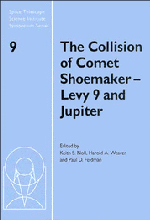Book contents
- Frontmatter
- Contents
- Participants
- Preface
- The orbital motion and impact circumstances of Comet Shoemaker-Levy 9
- Observational constraints on the composition and nature of Comet D/Shoemaker-Levy 9
- Tidal breakup of the nucleus of Comet Shoemaker–Levy 9
- Earth-based observations of impact phenomena
- HST imaging of Jupiter shortly after each impact: Plumes & fresh sites
- Galileo observations of the impacts
- Models of fragment penetration and fireball evolution
- Entry and fireball models vs. observations: What have we learned?
- Dynamics and chemistry of SL9 plumes
- Chemistry induced by the impacts: Observations
- SL9 impact chemistry: Long-term photochemical evolution
- Particulate matter in Jupiter's atmosphere from the impacts of Comet P/Shoemaker-Levy 9
- Jupiter's post-impact atmospheric thermal response
- Growth and dispersion of the Shoemaker-Levy 9 impact features from HST imaging
- Waves from the Shoemaker-Levy 9 impacts
- Jovian magnetospheric and auroral effects of the SL9 impacts
Entry and fireball models vs. observations: What have we learned?
Published online by Cambridge University Press: 12 September 2009
- Frontmatter
- Contents
- Participants
- Preface
- The orbital motion and impact circumstances of Comet Shoemaker-Levy 9
- Observational constraints on the composition and nature of Comet D/Shoemaker-Levy 9
- Tidal breakup of the nucleus of Comet Shoemaker–Levy 9
- Earth-based observations of impact phenomena
- HST imaging of Jupiter shortly after each impact: Plumes & fresh sites
- Galileo observations of the impacts
- Models of fragment penetration and fireball evolution
- Entry and fireball models vs. observations: What have we learned?
- Dynamics and chemistry of SL9 plumes
- Chemistry induced by the impacts: Observations
- SL9 impact chemistry: Long-term photochemical evolution
- Particulate matter in Jupiter's atmosphere from the impacts of Comet P/Shoemaker-Levy 9
- Jupiter's post-impact atmospheric thermal response
- Growth and dispersion of the Shoemaker-Levy 9 impact features from HST imaging
- Waves from the Shoemaker-Levy 9 impacts
- Jovian magnetospheric and auroral effects of the SL9 impacts
Summary
This review attempts to give a coherent explanation of the main observations of the entry Comet Shoemaker-Levy 9 and the aftermath of the resulting explosions by using models of the tidal breakup of the comet, the entry of individual fragments into the jovian atmosphere, and the resulting fireballs and plumes. A critical review shows that the models appear reasonably well understood. The biggest theoretical uncertainties currently concern how to best tie models of the entry to models of the resulting fireballs. The key unknown before the impact was the size and kinetic energy of the comet fragments. The evidence now available includes the behavior of the chain of fragments, the luminosity of the observed visible fireballs and later infrared emission, the chemistry of the spots, and the lack of seismic waves or perturbations at the water cloud pressure level. These observations point to the fragments having diameters under a kilometer, densities of order 0.5 g cm−3, and kinetic energies of order 1027 erg.
Introduction
In this review and in the review by Zahnle (this volume; hereafter “the plume review”), we make the argument that the fragments of Comet Shoemaker-Levy 9 that hit Jupiter were quite small, with diameters of under a kilometer and densities of order 0.5 g cm−3. The largest fragments probably had kinetic energies of order 1027 ergs.
- Type
- Chapter
- Information
- The Collision of Comet Shoemaker-Levy 9 and JupiterIAU Colloquium 156, pp. 157 - 182Publisher: Cambridge University PressPrint publication year: 1996
- 6
- Cited by

